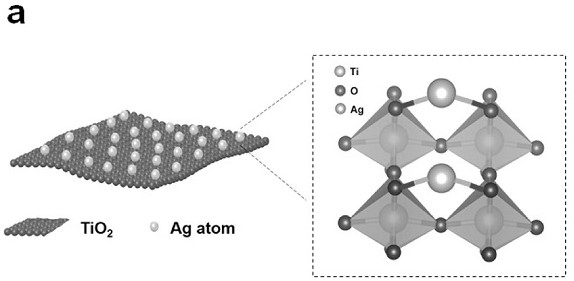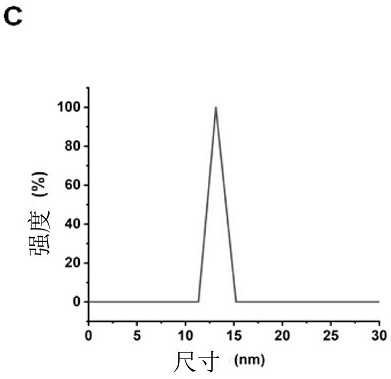Application of titanium oxide-loaded silver monatomic material in virus killing
A titanium oxide and atomic technology, applied in the field of biomedicine, can solve the problems of poor virus targeting, low catalytic activity, and body toxicity, and achieve the effects of good stability, high biological safety, and strong sensitivity
- Summary
- Abstract
- Description
- Claims
- Application Information
AI Technical Summary
Problems solved by technology
Method used
Image
Examples
Embodiment 1
[0086] The geometrical characterization of silver single atoms is shown in Figure 1. Scanning Electron Microscopy (SEM) and Dynamic Light Scattering (DLS) experiments were first used to examine whether Ag loading resulted in aggregated TiO 2 ; the results show that the carrier still has a uniform size distribution after loading, with a size of 10-15 nm (Fig. 1b-c). As shown in Fig. 1d–e, Ag atoms are dispersed in TiO 2 In Ag single atoms on the carrier, Ag, Ti and O elements are well distributed in the whole space. In contrast, when Ag NPs were observed, particles with a size of 3–5 nm were detected (Fig. 1f–g). Ag-TiO was investigated by Raman and solid-state ultraviolet-visible absorption spectroscopy (UV-vis) 2 The interaction spectrum of ( Figure 1h ). The peak around 450 nm is attributed to a size larger than 3 nm, further confirming the existence of Ag NPs. Figure 1i shows the TiO before and after Ag doping 2 The characteristic peak of , remained unchanged, but ...
Embodiment 2
[0088] Adsorption capacity of single-atom materials for coronaviruses: the analysis of single-atom materials with Ag loadings of 0.2 wt% and 1 wt% for SARSCoV 2The absorption capacity of pseudoviruses. The results showed that SAN loaded with 1% Ag exhibited a higher ability to adsorb pseudoviruses (Fig. 2a). We also compared and analyzed the adsorption capacity of the pseudovirus with the Ag loading of 1 wt% Ag single atom, the loaded Ag nanoparticles and the carrier. Surprisingly, the adsorption capacity of Ag single atoms to pseudoviruses was 99.65%, and the adsorption capacities of Ag nanoparticles and nano-TiO2 were only 90.62% and 82.71% (Fig. 2b–c). Finally, we confirmed the direct interaction between single atoms and pseudoviruses by scanning electron microscopy. Interestingly, we observed that pseudoviruses (smaller particles) were absorbed onto the surface of TiO-supported Ag single-atom materials (larger particles) (Fig. 2d–e). In skin test assays, Ag monoatomic a...
Embodiment 3
[0091] The reason for the ability of monatomic materials to adsorb viruses: Spike protein is SARS-CoV 2 The outermost structure responsible for binding to the host cell. We speculate that this uptake is partly dependent on the interaction of silver atoms with the spike protein. In this work, different materials were co-incubated with Spike 1 protein RBD, and then the supernatant was extracted for immunoassay. PBS is the blank control group of phosphate buffered saline, MOCK represents the cell group without material treatment; SAN represents the cell group treated with titanium oxide-loaded silver single atoms, and Ag represents the cells treated with titanium oxide-loaded silver nanoparticles Group, TiO 2 represents the group of cells treated with pure vehicle, TiO 2 +Ag refers to the group of cells treated with both titanium oxide support and silver ions. like Figure 3a As shown in -b, the absorption of S1RBD by Ag single atoms is higher than that of TiO 2 , Titanium ...
PUM
| Property | Measurement | Unit |
|---|---|---|
| The average particle size | aaaaa | aaaaa |
| Concentration | aaaaa | aaaaa |
Abstract
Description
Claims
Application Information
 Login to View More
Login to View More - R&D Engineer
- R&D Manager
- IP Professional
- Industry Leading Data Capabilities
- Powerful AI technology
- Patent DNA Extraction
Browse by: Latest US Patents, China's latest patents, Technical Efficacy Thesaurus, Application Domain, Technology Topic, Popular Technical Reports.
© 2024 PatSnap. All rights reserved.Legal|Privacy policy|Modern Slavery Act Transparency Statement|Sitemap|About US| Contact US: help@patsnap.com










